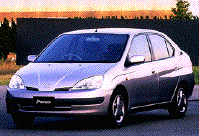 Science & Technology || Search || Back Numbers ECOLOGY-CONSCIOUS CARS:
 Get ready to see more hybrid cars on the road. (Photo: Toyota Motor Corp.) Problems affecting the global environment are on everyone's mind these days, and the world's leading automakers are no different. One product of such thinking has been the development of environment-friendly vehicles; the first such vehicle to be commercialized will go on sale in Japan at the end of 1997. The forerunner of a new generation of low-polluting automobiles is a hybrid car with a gasoline engine and electric motor. The automaker reports that orders for the new vehicle have been higher than expected. A fuel-efficient car that uses a direct-injection engine has been on the market for a year, moreover, and other ecological vehicles are soon expected to be commercialized as well, including electric cars and those that run on compressed natural gas and fuel cells. Marketing the Hybrid Car The engine is constantly generating electricity when it is operating, and the power that is thus acquired is used to rotate the motor, which then supplements the engine. Since power is generated by the engine, there is no need for recharging. The 1500 cc hybrid car that Toyota Motor Corp. is putting on the market in December 1997 will have double the fuel efficiency of conventional gasoline-powered cars. Carbon dioxide emissions will be halved, and emissions of carbon monoxide and nitrogen oxide will be one-tenth of permissible standards. The price tag on the hybrid car will be 2.15 million yen (16,500 U.S. dollars at 130 yen to the dollar), about 30% more than the price of an ordinary car of the same engine capacity sold by the carmaker. The company explains that it has set the price as close to the break-even point as possible in the hope that drivers will embrace the new vehicle as a countermeasure against global warming. The strategy seems to have worked, as orders for 1,000 vehicles were placed in less than four weeks after they started being accepted, easily clearing the monthly target. Other carmakers also are proceeding with the development of hybrid cars, with commercialization plans for as early as 1998. Manufacturers are also expanding their lineup of cars with direct-injection engines, which began appearing in the second half of 1996. The direct injection of fuel increases combustion efficiency and reduces the emission of carbon dioxide by about 30% from conventional vehicles. Mitsubishi Motors Corp., which pioneered the sale of these vehicles, plans to double their production from the spring of 1998. Just a little more than a year after the direct-injection automobile went on sale, more than 100,000 units have been produced, and this type of engine is now featured in most of the manufacturer's models. The Ultimate Clean Car The biggest bottleneck has been the difficulty of making conventional lead storage batteries lighter and increasing their capacity. To solve this problem, makers have developed other types of batteries, such as nickel-hydrogen and lithium-ion. Improvements are being made to produce electric cars that have better performance and are easier to use. At present, the distance an electric car can travel on a single charge is quite limited, so the key to its proliferation will be the development of a high-performance battery. Research is also being carried out to develop the "ultimate clean car" that runs on hydrogen-powered fuel cells. Since electricity is generated through reverse electrolysis, the vehicle would emit only water, and recharging would not be necessary. Auto makers around the world, including those in Japan, are looking into this possibility, although commercial production is probably still far off in the future. As for vehicles that run on fuel other than gasoline, one type of car that is already being used by gas companies and governmental organizations runs on compressed natural gas. About a thousand such cars, which are cheaper to operate than electric vehicles, are now on the road. Efforts by Society Low-pollution vehicles are still very expensive, and the lack of facilities to service them pushes maintenance costs up as well. For this reason, such vehicles tend to be leased; sales are limited to public bodies and large companies. Costs are high for the manufacturers, too, as the development of environment-friendly technology requires huge investments; we may soon see a war of attrition among the automakers. If and when the mass production of electric vehicles begins, it will then become possible for makers to lower prices and set up the necessary infrastructure, such as recharging facilities. Consumers are taking an increasing interest in the environment, so if the price is right, low-pollution vehicles have the potential to become quite widespread. From now on, though, input from a wider segment of society than just carmakers will become necessary; one example of such input would be subsidies from the central and local governments.  Edited by Japan Echo Inc. based on domestic Japanese news sources. Articles
presented here are offered for reference purposes and do not necessarily
represent the policy or views of the Japanese Government.
Edited by Japan Echo Inc. based on domestic Japanese news sources. Articles
presented here are offered for reference purposes and do not necessarily
represent the policy or views of the Japanese Government.
|
